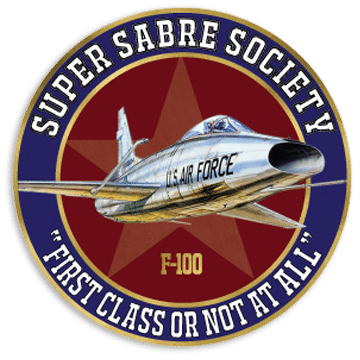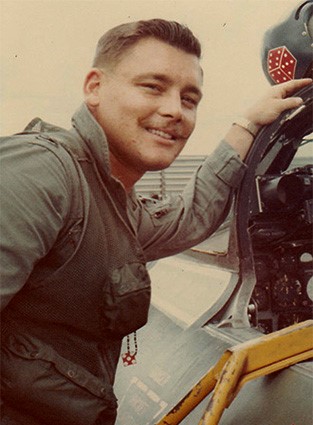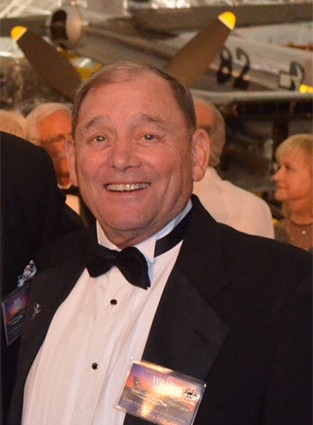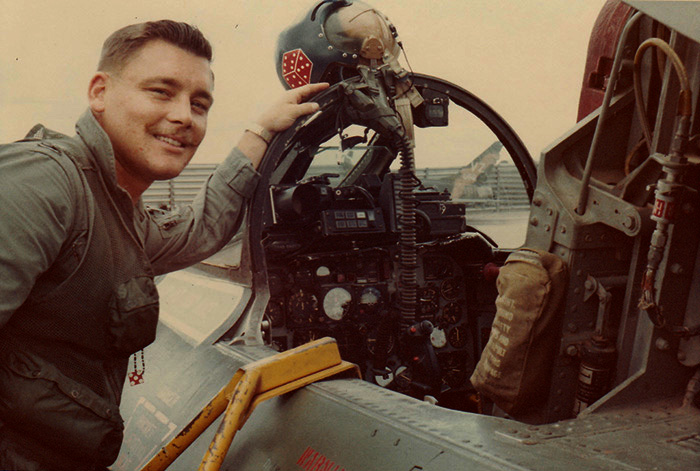The Tallest Tree
Lots of guys took hits in Vietnam … and a few unlucky ones got shot down. I was one of the unlucky ones. Here’s the story. It’s “Mother’s Day” 1969, I’m 11 months into my Vietnam tour, and the sun is just coming up at Bien Hoa. Air Base in South Central Vietnam.
I’m leading a scramble from the alert pad with Lt. Ben Smith as my wingman. We’re defending an Army base camp just 20 miles west. Our load is napalm, high drags (general-purpose bombs), and 20mm machine gun rounds. The plan is for restricted run-in headings with multiple passes (perhaps too many?). After expending my nape (napalm) along a tree line, my wingman, Ben, is dropping his 500lb high drag bombs.
Having expended all my ordnance, I can just hang out and watch him, or I can continue to attack the target with my 20 mm. I began strafing behind Ben’s high drag pass at a gunner with a 50 caliber (me vs the 50, not a very good idea). On about my third pass, the gunner scores a hit. The belly on my jet is ripped open. I’ve got no hydraulics, no oil, I’m streaming fuel, almost all the warning lights are on and the flight controls are frozen. The plane’s in a slow climb away from the target. I make a Knock it off 1 call and then make calls to the FAC and my wingman.
Our attack is terminated and I’m focusing on the emergency at hand. The flight changes to the GUARD channel (standard emergency channel) and I hope rescue plans are being set in motion. At 10,000 feet with airspeed decreasing below 180 knots (kinda textbook), I figure it’s time to leave the Hun (F-100).
Up and away!
The seat explodes upward and I accelerate over the engine in full mil power2 … very loud. As the aircraft rockets away, it becomes very, very quiet. I’m alone in the sky and I’ve got to say, floating down from 10,000 feet is quite peaceful. Just me swinging beneath the silk, coming down at 1,000 feet/minute – about 10 minutes to the ground.
The “cut-four”3 takes a little courage ‘cause why would you ruin a perfectly good chute? But it stops the oscillations and now I’m descending at about 800 feet/minute – maybe 12 minutes to the ground. Comfortable ride, quiet, no wind (I’m the wind). I take a sip of water from my flask and begin looking around, pulling the shroud lines left and right for a better view.
There’s lots of trees but I see a clearing a mile or so in front that looks like a good place to set down. Uh-oh, as I get closer I realize the clearing is merely a circle where a “daisy-cutter”4 has blown all the leaves off the trees.
The trees left standing look like punji sticks in the ground, actually, more like umbrellas with the cloth torn off. But I’m committed and this is where I’m landing. I go crashing through the upper branches and the parachute gets caught. I spring upward tumbling through the shroud lines and down again, and up again and down again until the bouncing stops and I’m hanging from a tree … a pretty tall tree.
When I reach for the descent rope and let it drop to the ground it falls a little short … in fact, really short of the ground. I shake the rope again. I’m not sure whether the rope is 50, 75 or 100 feet long, but I know it isn’t long enough. It’s easily 25 feet short. Sliding gracefully down the rope isn’t going to cut it. The trunk of the tree must have been 20 feet away from where I’m hanging and for a minute I consider swinging back and forth to grab the trunk but realize the math doesn’t work.
Back to the rope. I pull on it to make sure it’s fully deployed and shake it again to see how far it is above the ground. No change, it’s still isn’t even close to touching the ground. This is one very tall tree. I survey the area around me. The “clearing” that I landed in was a circle probably 50 meters across. I seemed to be hanging from the tallest tree in almost the center of the circle. It occurs to me that I’m pretty much a sitting duck if the Viet Cong should find me.
I check for the 38 -caliber pistol which is issued to all pilots and I’m happy that I have it. It won’t do me a lot of good, but I feel better knowing it’s there. I start to feel a little more urgency to get down from the tree but taking stock in my situation I realize I’m hanging in a very tall tree in the middle of a war zone in Vietnam. Maybe I’ll just hang here rather than be more conspicuous on the ground.
Suddenly I notice something move over my left shoulder. There’s a rope ladder dangling from an Army chopper! The chopper had heard my call on GUARD and had monitored the entire ejection. It was now hovering just above the tree branches and right above me. This was going to work out all right. I grab the ladder, put my legs through it, and am ready to be whisked away, but realize I’m still wrapped in the shroud lines from the parachute. As the helicopter begins to move away, I’m suspended from the rope ladder and the parachute shroud lines are wrapped around my entire body.
I wave desperately for the helicopter to put me back. Slowly, gradually, I’m eased back under the shroud lines. I get out of the ladder and discover the chopper driver has put me back exactly where I had started. I wave them away … nice try … but this just isn’t going to work. It was a great idea, but I guess I’m just going to hang in this damn tree until the war is over.
A few minutes later the rope ladder reappears. Though his instruments were in the red, the chopper pilot positioned his plane right above me again. I look up and see an Army sergeant climbing down the ladder. He’s got a knife in his teeth and looks a little like a pirate…he’s coming down the ladder to get me. This is unbelievable…right out of the movies.
When he’s next to me, I climb back on the ladder and he cuts the shroud lines from around my neck, working his way down my body, cutting lines until I’m free from the chute. Now both of us are clinging to a rope ladder and each other beneath the helicopter. I’m sure the sergeant didn’t fly around like this every day, but now he’s my rock and I’m hanging onto him with a death grip.
We fly like this for the 15 or so miles back to the base until the chopper lowers us gently to the ground. I want to kiss the sergeant, but instead, I shake his hand. In fact, I shake the hands of everyone I see! I decide to give the sergeant the dice that hang on my flight suit …it’s the only thing I have and I hope he understands what the dice mean to me.
I watch him re-board the copter and off he goes. All in a day’s work – Amazing! Note: 7th Air Force issued an order that afternoon. There would be no more flights with two lieutenants.
In His Words: “My Dad was an AF pilot for 32 years and I always wanted to fly. The jets got more powerful, more forgiving, and more capable … but they were never as much fun as flying the Hun.”
The Man: Colonel James V. Williford was commissioned in the Air Force after graduating from the United States Naval Academy in 1966 with a bachelor’s degree in Engineering. He also earned a Master’s Degree in Public Administration from the University of Northern Colorado in 1975. After graduation from pilot training at Reese AFB, TX and fighter training at Clovis AFB, NM he spent the next 30 years flying F-100’s, F-4 D&E’s and F-16. Jim retired from the Air Force in 1996 with more than 3,000 flying hours. (source: https://airandspace.si.edu/support/wall-of-honor/col-james-v-williford)
Colonel Jim Williford is currently the Executive Secretary of the Super Sabre Society.
- full mil power: maximum power (without afterburner). When ejecting the aircraft the seat is propelled up and away from the airplane…as the airplane slides beneath you, you are right over the roaring engine…and it is very loud.
- ”Knock it off” is the standard radio call taught in pilot training and carried throughout the Air Force. It can be made by any flight member and means for everyone in the flight to stop what they are doing immediately, usually, because someone has an emergency or there is a dangerous situation developing.
- “cut four”:: cutting the 4 lines in the back of the parachute to minimize forward speed
- “daisy cutter”: a 3 – 4-foot extender on a bomb which causes it to detonate at the surface rather than digging a crater. Often used to clear out an area for a landing zone or drop zone for the Army.
James V. Williford, Col USAF, Ret., “Headed West” on January 13, 2025.
 Jim Williford, the beloved Executive Secretary of the SSS, “Headed West” on January 13, 2025 after a prolonged illness. He was preceded in death by his wife Cissy.
Jim Williford, the beloved Executive Secretary of the SSS, “Headed West” on January 13, 2025 after a prolonged illness. He was preceded in death by his wife Cissy.
Jim entered the Air Force in 1968 and retired in 1996.
More information to follow.











